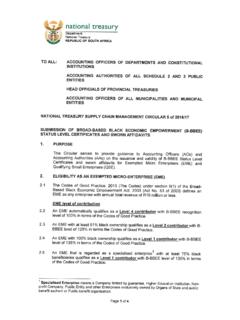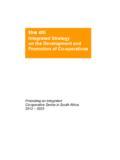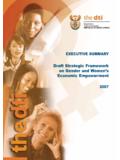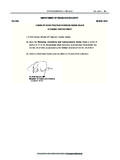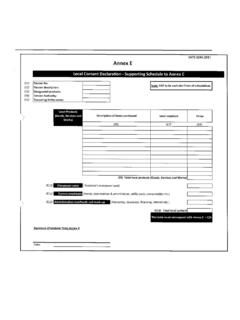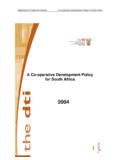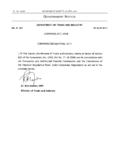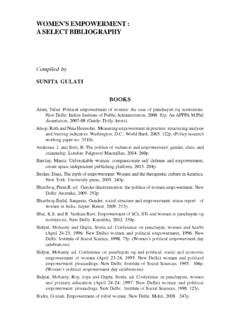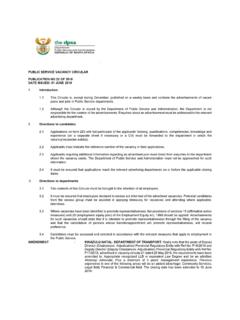Transcription of A Guide to Interpreting the Codes Chapters Five to Six ...
1 THE Codes OF GOOD PRACTICE: PHASE ONE 2005 A Guide to Interpreting the Codes Page No.: 22 Chapters Five to Six: Code 100 Measurement of the Ownership Element of Broad-Based Black Economic Empowerment Chapter Five: Statement 100 The General Ownership Scorecard and the Recognition of Ownership Arising from the Sale of Equity Instruments Introduction Transactions which were concluded during the first wave of BEE in the late 1990s began to reveal that transformation of the nature of BEE deals themselves was required.
2 In particular, the need to address the following issues with respect to some BEE transactions, was revealed: The lack of participation by black women in BEE consortia The reversion of black equity into the hands of the original white owners, following the collapse of BEE deals, owing to onerous structuring and repayment terms The fact that often the BEE ownership status of entities was inflated when compared to the actual economic benefits flowing to the black beneficiaries, since economic benefits were often eroded by financing restrictions The lack of participation by broad-based beneficiaries such as black rural dwellers, black unemployed people, black workers, black disabled and impoverished black communities (included in the definition of black designated groups)
3 The fact that deals were primarily concluded amongst a select number of BEE personalities since there was no incentive for companies to look beyond these prominent black players Fronting Statement 100 aims to address all of these issues by providing specific incentives in the ownership scorecard to ensure participation by black women, black designated groups and new entrants and to ensure that only real economic interest in the hands of black people is measured. Components of the Ownership Scorecard In order to measure the extent of black ownership participation, the ownership scorecard measures the different rights normally attached to ownership.
4 These rights are: Control: Control of the Enterprise, through the exercise of voting rights at shareholder meetings Economic Interest: The entitlement of black people to dividends, capital gains and other economic rights of shareholders Net Equity Interest: The accumulated net economic interest in the hands of the black shareholders, after the deduction of monies owed by these black shareholders. Overview & Objectives To measure the extent of real black ownership of a measured enterprise, by means of an ownership scorecard THE Codes OF GOOD PRACTICE: PHASE ONE 2005 A Guide to Interpreting the Codes Page No.
5 : 23 How the Scorecard Resolves the Issues Surrounding BEE Transactions: Category Ownership criteria Weighting points Compliance Target Voting rights: Exercisable Voting Rights in the Enterprise in the hands of black people 3 25%+1 vote Exercisable Voting Rights in the Enterprise in the hands of black women 2 10% Economic Interest.
6 Economic Interest in the Enterprise to which black people are entitled 4 25% Economic Interest in the Enterprise to which black women are entitled 2 10% Economic Interest in the Enterprise to which the following natural persons are entitled: black designated groups; or black Deemed Participants in Distribution Schemes or Employee Schemes 1 Realisation points: Ownership fulfilment 1 No Restrictions Net Equity Interest 7 Year1 5% Year 2 Up to 25% in year 10 Bonus points.
7 Involvement in the ownership of the Enterprise of: black new entrants; or black Deemed Participants of Broad-Based Ownership Schemes 3 15% Voting Right: Measures ab ilit y of black peop le t o cont rol a nd/ or inf lue nce meas ured e nt it y Account f or 5 point s (out of 20 poi nt s)Economic Interest: Measures bl ack peo ple s lega l ent it lem ent t o receive dividend and capital gains Account f or 7 point s (out of 20 own ershi p poi nt s) Real i sati o n Po i n ts: Measures al l black p eop le s ef f ect ive owners hip of shar es (exclud ing t he im pact of f inanci ng an d ot her rest rict io ns and red uce t he scen arios w here no real ec onom ic ben ef it s pass t o t he hand of black p eop le)Bo n u s Po in ts.
8 Measures p art icip at ion by n ew ent rant s and br oad- base d schemes in o wners hipBl ack De si g n atedG ro u p s an d Bro ad -b ased SchemesBroad-b ased sch emes, desig nat ed gr oups a nd ne w ent rant s wil l provi de measured enterpr ises with the abil ity to access 4 scorecard and bo nus po int sBl ack W o menT here are f our po int s specif ica lly req uire t he part icip at ion by b lack wom en. A measured e nt erpris e wil l not be all ocat ed t hes e poi nt s wit hout bl ack wome n part icip at ion The ownership scorecard provides specific recognition of ownership participation by black women or black designated groups.
9 As a result, a measured enterprise will only achieve full ownership points if there is equity participation by black women and black designated groups or broad-based schemes in its ownership structure. THE Codes OF GOOD PRACTICE: PHASE ONE 2005 A Guide to Interpreting the Codes Page No.: 24 The scorecard aims to ensure that a measured enterprise will consider its black shareholders ownership rights and their status when structuring a transaction to introduce black ownership or when formulating a new enterprise with black owners.
10 Key Definitions and Principles: The term "black people" includes all African, Coloured or Indian persons who are South African citizens by birth or by descent or who were naturalised prior to the commencement of the constitution in 1993. In addition, the term also includes black people who became South African citizens after the constitution s commencement but who would have been able to be naturalised prior to this, were it not for the Apartheid laws that prohibited naturalisation of certain persons. This means that an African, Coloured or Indian person who was not a South African citizen before the commencement of the constitution in 1993 but who would have been entitled to apply to be naturalised prior to 1993, will also be considered a black person and therefore a beneficiary of BEE.
